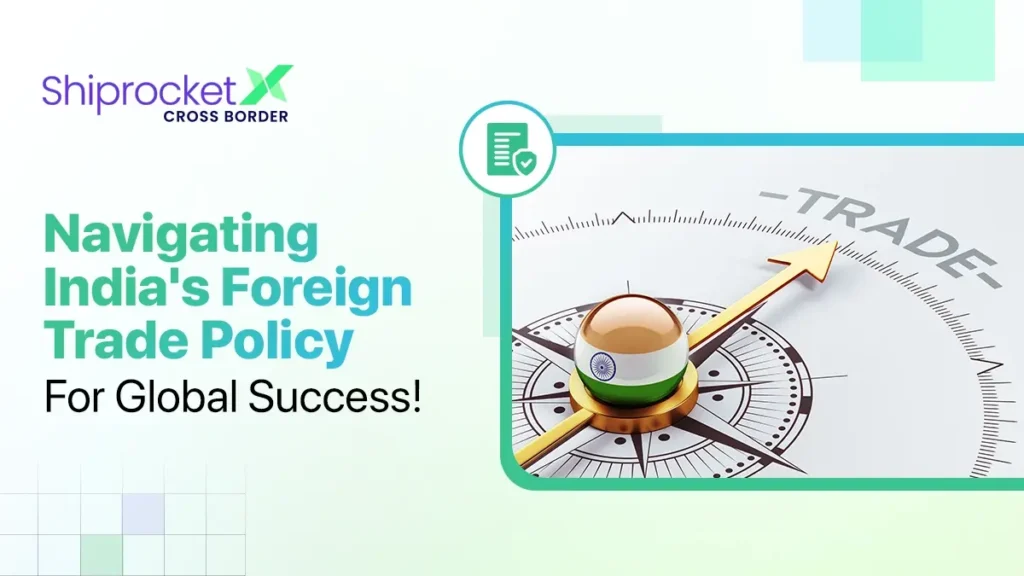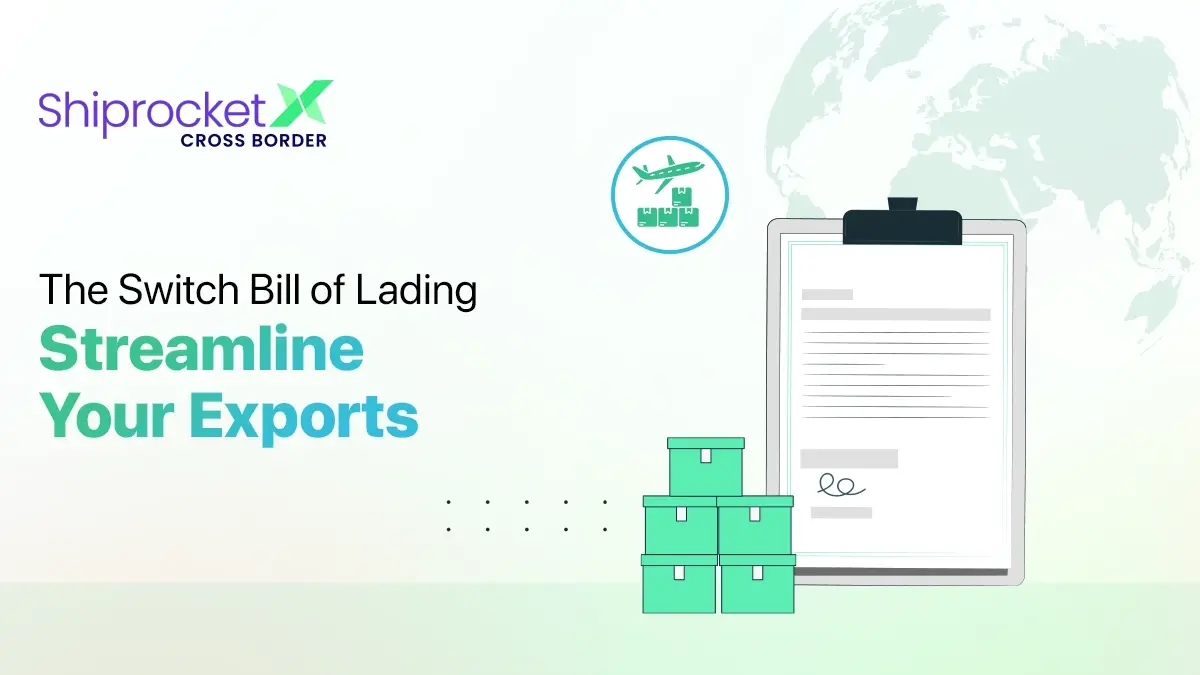India’s Foreign Trade Policy 2023: Boosting Exports
- India’s Foreign Trade Policy or EXIM Policy
- Goals of the Foreign Trade Policy 2023
- Foreign Trade Policy 2023: Key Points
- Effect of Foreign Trade Policy 2023 on Exports
- EXIM Infrastructure in India
- Proceedings to Register an EXIM Unit
- Mandatory Documents for EXIM Units to Engage in Foreign Trade
- Government Initiatives to Encourage Export Business
- Organisations and Government Initiatives Promoting EXIM Trade
- Achieve Seamless Operations for your eCommerce Business with ShiprocketX
- Conclusion
India’s foreign trade policy, or FTP, is a strategic plan that guides the country’s foreign trade operations. With the introduction of FTP 2023, the emphasis has turned to increasing exports and making export business easier for companies. This policy significantly focuses on the “export control” system, which is a proactive method of handling trade-related matters. Here, we will examine the main goals and characteristics of India’s Free Trade Policy and the programme’s contribution to export growth in India.

India’s Foreign Trade Policy or EXIM Policy
The Foreign Trade Policy (FTP), formerly referred to as the Export-Import (EXIM) Policy, regulates the import and export activities in the country. FTP establishes rules and regulations that govern foreign trade to facilitate the smooth flourishing of businesses. The Foreign Trade Development and Regulation Act approved in 1992 was an initiative towards this.
The Ministry of Finance in collaboration with the Union Minister of Commerce and Industry and the Directorate General of Foreign Trade (DGFT) is responsible for updating India’s Foreign Trade Policy (FTP) at regular intervals. Every year on March 31st, the Export-Import Policy, or EXIM Policy, is amended. New initiatives, enhancements, and revisions take effect on April 1st of the same year.
India’s global commerce operations benefit greatly from the trade processes outlined in the Foreign Trade Policy. The most recent version, FTP6 2023–2028, came into effect on April 1, 2023. The new FTP policy attempts to support the nation’s goal of being self-sufficient to establish itself as a major trade center internationally.
FTP seeks to increase economic growth and create jobs. It is established on the following four pillars:
- Incentive to remission
- Promoting collaboration among exporters, states, and districts
- Facilitating ease of doing business
- Exploring emerging areas such as eCommerce and SCOMET policy streamlining.
Goals of the Foreign Trade Policy 2023
The following are the goals of India’s Foreign Trade Policy (FTP) 2023:
- Promote economic growth by increasing import and export.
- Enhance access to resources and capital goods that can promote long-term economic expansion.
- Boost industry competitiveness in agriculture, services, and other sectors while maintaining quality standards and generating employment.
- Ensure everyone has access to reasonably priced, high-quality goods and services.
- Promote international integration in line with India’s development goals.
- Assist India in its ambition to rank among the top exporting countries while preparing for upcoming obstacles.
- Promote exports at the district level by working with state governments.
- By 2030, triple the exports of goods and services to a total of USD 2 trillion, achieving substantial growth potential.
Foreign Trade Policy 2023: Key Points
A few key points of FTP 2023 are highlighted below:
- Re-engineering and Automation of Processes
The new FTP prioritises automated IT systems with risk management for exporter permissions, moving the focus from incentives to convenience. It encourages the implementation of advanced technologies and will help sustain current initiatives such as Advance Authorisation (AA) and EPCG. Export duty exemption will be administered regionally by IT systems, gradually including AA and EPCG scheme operations. Processing will be automated for most applications, streamlining exporters’ operations.
- Towns of Export Excellence (TEE)
In addition to the current 39 towns, four more towns Faridabad, Mirzapur, Moradabad, and Varanasi have been named Towns of Export Excellence (TEE). Under the EPCG programme. These TEEs can utilise the advantages of Common Service Providers (CSPs) to accomplish their export obligations, and they will have the highest priority on export promotion money under the MAI programme. This programme attempts to increase carpet, handicraft, and handloom exports.
- Recognition of Exporters
Exporter companies will actively engage in capacity-building initiatives if awarded a “status” based on their export performance. A defined curriculum will be used to encourage individuals with 2-star and above classifications to offer trade-related training. The goal of this programme is to develop a workforce with the necessary skills to help India achieve its goal of being a USD 5 trillion economy by the year 2030. To improve branding prospects in export markets, the recognition standards have been modified to allow more enterprises to achieve 4- and 5-star ratings.
- Promoting District-Level Exports
Through strategic relationships with state governments, district-level exports are given priority under the Foreign Trade Policy (FTP). It also establishes the Districts as Export Hubs (DEH) under a programme that aims to address local issues and find goods that are suitable for export. This is made possible by institutions such as State and District Export Promotion Committees. The FTP also lays down district-specific export action plans that are specifically designed to facilitate the marketing of designated goods and services.
- Streamlining SCOMET Policy
India reinforces its export control policy, placing a focus on compliance with international norms. The goal is to satisfy international agreements by improving the Special Chemicals, Organisms, Materials, Equipment, and Technologies (SCOMET) policy. As a result, exports in compliance with SCOMET standards are made easier, and a strong export control system is maintained.
- Facilitating eCommerce Exports
The FTP 2023 emphasises the significance of eCommerce exports, projecting a potential USD 200 to USD 300 billion worth of trade by 2030. The government plans to accomplish this feat by creating set-up plans for eCommerce sites and taking care of important issues including export authorisation, bookkeeping, and payment reconciliation. With possible input-based changes, the FTP raises the maximum amount that can be exported from eCommerce via courier services from INR 5 lakhs to INR 10 lakhs. It promotes ICEGATE integration, which seeks to offer benefits and efficiency.
- Facilitation under the Export Promotion of Capital Goods (EPCG) Scheme
Under FTP 2023, the EPCG Scheme permits the duty-free import of capital goods. The PM MITRA programme and dairy industry exemptions are among the improvements provided under the new policy. Export duties on green technology items have also been reduced. Improved features like the Special Advance Authorization Scheme (SAAS) for the apparel sector have also been added to the Advance Authorization Scheme (AAS). Benefits for status holders have been increased, which improves exporter efficiency.
- Merchanting Trade
To position India as a center of international trade, FTP 2023 implements measures allowing the export of items prohibited or restricted by export law. This policy also states that through the use of an Indian agent, goods can be sent from one foreign nation to another without passing through Indian ports. For this, conformity with RBI standards will be required. Goods and commodities included in the CITES and SCOMET lists will not be eligible under this strategy. The goal of this initiative is to transform some locations, like GIFT City, into important global commerce hubs like those in Dubai, Singapore, and Hong Kong.
- Amnesty Scheme
Under FTP 2023, the government offers a special one-time amnesty scheme to help exporters overcome obstacles. This programme, which is in line with the “Vivaad se Vishwaas” concept, releases exporters from requirements on Advance Authorisations and EPCG. Interest on unpaid export requirements may be capped at 100% of exempt tariffs, and all outstanding default cases may be regularised. The objective of this project is to offer exporters who are struggling with high duty and interest expenses a chance to start again.
Effect of Foreign Trade Policy 2023 on Exports
The new foreign trade policy 2023 is predicted to have the following effects:
- Micro, Small, and Medium-Sized Enterprises (MSMEs) in the export industry are given priority in the New Foreign Trade Policy (FTP) 2023. This will benefit their growth.
- Lowering the exporter recognition criterion makes it possible for smaller exporters to get higher status. This will open up the eligibility for advantageous programmes and cut down on transaction expenses.
- To encourage MSME exports, user fees for MSMEs under important programmes like Advance Authorisation and EPCG have been restricted to INR 5,000.
- Significant export growth is anticipated as a result of programmes encouraging export-hub areas and enabling eCommerce exports.
- Measures to streamline export processes are introduced in FTP 2023, which will especially help MSMEs increase corporate productivity.
- Adherence to WTO regulations guarantees the persistence and steadiness of duty-remission programmes, providing reassurance to industry participants.
- Exporter trust is increased when duty-remission programmes like RoDTEP and RoSCTL are combined with prompt government payments.
- It is expected that the Amnesty Scheme, which addresses default on export obligations under FTP 2023, will provide exports a new lease of life, demonstrating government support.
- FTP 2023 is expected to stimulate export activity, particularly for MSMEs, and establish a favourable climate for continued export expansion.
EXIM Infrastructure in India
India’s EXIM system makes it easier to trade commodities across borders in several ways:
- Maritime Transport: Over 95% of India’s commerce volume is handled via sea transport, which the country greatly depends on. The largest port in the nation, Jawaharlal Nehru Port Trust (JNPT) in Maharashtra, handles over 55% of container freight.
- Port Network: The Government of India launched the Sagarmala Programme with the objective of reducing logistical expenses and promoting industrial growth. It plans the creation of 14 coastal economic zones and six new significant ports.
- Road Network: India is building 40 km of national roads per day, with the goal of quickly developing its road network. Launched in 2015, the Bharatmala Pariyojana aims to connect 550 districts with four-lane national roads and build new economic corridors.
- Rail Network: India’s railway network, which moves more than 1.2 billion tonnes of freight a year, is essential to the country’s trade. To enhance rail freight capacities, the nation is building six high-capacity, high-speed freight lines.
Proceedings to Register an EXIM Unit
The process of establishing an export-import unit in India is simple to follow:
- Creating a unit: In accordance with the necessary procedure, begin by forming a single proprietary concern, partnership firm, or company.
- Creating a bank account: Open a current account at a bank that is permitted to handle foreign exchange transactions.
- Getting a PAN(Permanent Account Number): The Income Tax Department issues PAN cards to all importers and exporters.
- Getting an IEC (Importer-Exporter Code) number: It is necessary to obtain the IEC to import and export from India. Apply online using the DGFT, send in the necessary paperwork, and pay the INR 500 application fee.
- Registration Cum Membership Certificate (RCMC): To be eligible for advantages under the Foreign Trade Policy, you must get a Registration Cum Membership Certificate (RCMC) from the appropriate Export Promotion Councils like FIEO, Commodity Boards, or other agencies.
- Risk coverage via ECGC: Reduce the risks associated with foreign commerce by using appropriate insurance from ECGC. This is particularly needed when working with buyers who lack letters of credit or give advance payments.
Mandatory Documents for EXIM Units to Engage in Foreign Trade
Proper export-import documentation specified by the Directorate General of Foreign Trade (DGFT) is necessary for smooth operations. The following are some of the important documents:
For Export:
- Bill of lading: Airway bill, Lorry receipt
- A postal receipt
- The packing list cum commercial invoice
- Bill of export, shipping bill, or postal bill of export
For Import:
- Bill of lading, airway bill, lorry receipt, railway receipt, or postal receipt in Form CN-22 or CN-23
- Commercial invoice cum packing list
- Bill of entry
It may be necessary to submit further documentation, including a certificate of origin and an inspection certificate. Other crucial procedures include filing the exchange control declaration, the bank realisation certificate, the GST return forms (GSTR 1 and GSTR 2), and the Registration Cum Membership Certificate (RCMC).
Government Initiatives to Encourage Export Business
The government has put in place several programmes to support and foster export-oriented businesses, such as:
- On March 31, 2023, the New Foreign Trade Policy was proposed, which came into force on April 1st, 2023.
- With an extra grant of INR 2500 crores, the Interest Equalisation Scheme on pre- and post-shipment rupee export credit is extended till June 30, 2024.
- Supporting export-related initiatives such as the Market Access Initiatives (MAI) Scheme and the Trade Infrastructure for Export Scheme (TIES).
- To encourage exports from the labour-oriented industry, the Rebate of State and Central Levies and Taxes (RoSCTL) Scheme came into effect on March 7, 2019.
- Launched on January 1, 2021, the Remission of Duties and Taxes on Exported Products (RoDTEP) programme expanded its reach to include other industries, such as chemicals and pharmaceuticals.
- Establishing a common digital platform for certificates of origin to improve the use of free trade agreements (FTAs) and expedite trade processes.
- Launching the Districts as Export Hubs project by identifying goods in each district that have the potential to be exported and assisting regional exporters in creating jobs.
- Increasing the proactive role of Indian embassies overseas in advancing commerce, tourism, technology, and investment goals.
To maximise local market growth and broaden its worldwide reach, the government has also put in place the following measures:
- Pradhan Mantri Gati Shakti initiative
- National logistics Policy
- National Industrial Corridor Development Programme
- GIS-enabled Land Bank – India Industrial Land Bank (IILB)
- Industrial Park Rating System (IPRS)
- Productivity Linked Incentive (PLI)
- Make in India
- Startup India
- One District One Product
- National Single Window System
All of these programmes are meant to increase exports, foster growth in the home market, and fortify India’s position in the international arena.
Organisations and Government Initiatives Promoting EXIM Trade
The Indian government has successfully set up several organisations and initiatives to promote exports and import trade to global markets. These include:
- The Market Access Initiative (MAI) scheme: It helps trade associations, export promotion organisations, and other institutions grow their market share or reach new markets to increase exports.
- Transport and Marketing Assistance (TMA) for specific agricultural products: Promotes the worldwide marketing of agricultural products and helps to reduce the freight disadvantage of exporting them.
- Sector-specific boards offer export promotion schemes: The Marine Products Export Development Authority (MPEDA), the Agricultural and Processed Food Products Export Development Authority (APEDA), and other sector-specific boards support exporters in their particular sectors.
- Districts as Export Hubs initiative: To encourage local exports, find goods and services in every Indian district that have the potential to be exported.
- The Trade Infrastructure for Export Scheme (TIES): It offers assistance to federal and state government organisations in creating infrastructure that promotes the expansion of exports.
- Remission of Tariffs and Taxes on Exported Products (RoDTEP): It provides reimbursement for federal, state, and municipal taxes, tariffs, and levies paid throughout the production and distribution of goods that are exported.
- Communal digital certificate of origin platform: It streamlines trade processes and encourages exporters to use Free Trade Agreements (FTAs).
- Champion services sectors: Through specialised action plans, twelve important service sectors are identified and promoted to diversify and increase services exports.
- The Commodity Boards, Indian Missions Abroad, and Export Promotion Councils (EPCs): These play an enhanced role in actively promoting India’s trade, tourism, technology, and investment goals worldwide.
Achieve Seamless Operations for your eCommerce Business with ShiprocketX
For your eCommerce business, Shiprocket offers innovative solutions to boost your success. Organise all of your shipping channels in one location and use AI to choose the most reliable shipping partner to streamline domestic delivery. With reliable courier partners, you can enjoy fast intra-city deliveries. With ShiprocketX for shipping to more than 220 international destinations, CargoX for transparent B2B air deliveries, and LaunchX for low-risk foreign market entrance, you can offer services for international customers.
Conclusion
FTP 2023 presents a dynamic roadmap to elevate India’s export potential and foster substantial growth in the years ahead. This policy empowers you to expand your eCommerce exports and capitalise on emerging opportunities by streamlining processes, leveraging technology, and promoting collaboration. With FTP 2023 guiding your journey, you can position your business as a key player in the global market, driving prosperity and success for yourself and contributing to India’s export prowess.




